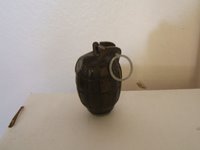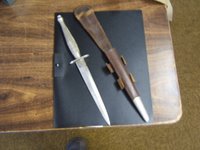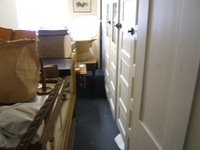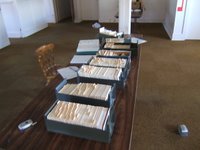 With the volunteers busily working, the project continues to make some great headway. Last week town staff arranged the removal of some of the large, antique, display cases to off-site storage. Now the old factory floor of the Jones Shovel Factory has space to bring in shelving and will hopefully provide a lasting storage space for Gananoque’s historical collections. There are many challenges to the space: the ceiling is a bit high and it will be a struggle to keep the humidity under control, but it is the best option we have found so far. The large windows have been covered so we have successfully resolved the light issue.
With the volunteers busily working, the project continues to make some great headway. Last week town staff arranged the removal of some of the large, antique, display cases to off-site storage. Now the old factory floor of the Jones Shovel Factory has space to bring in shelving and will hopefully provide a lasting storage space for Gananoque’s historical collections. There are many challenges to the space: the ceiling is a bit high and it will be a struggle to keep the humidity under control, but it is the best option we have found so far. The large windows have been covered so we have successfully resolved the light issue.We had five volunteers working in our space at the former Textron plant
 this past week. To date we have inventoried some 720 artefacts (approximately 17%), and have removed hundreds of photographs from damaging frames and self-adhesive albums. Some damage has been quite severe, but we have reached other photos just in time. When this phase of the project is complete we will have the whole collection scanned and it will be available for the town’s people. Luckily, we have Eileen Truesdell and John McDonald working on the photos, and their knowledge of the town has provided some great information for what would have remained anonymous pictures.
this past week. To date we have inventoried some 720 artefacts (approximately 17%), and have removed hundreds of photographs from damaging frames and self-adhesive albums. Some damage has been quite severe, but we have reached other photos just in time. When this phase of the project is complete we will have the whole collection scanned and it will be available for the town’s people. Luckily, we have Eileen Truesdell and John McDonald working on the photos, and their knowledge of the town has provided some great information for what would have remained anonymous pictures. Aidan Baker and his mother Cathy are among our most enthusiastic volunteers and have been working with intern Erin Findlay on cleaning and cataloguing a collection of 200 or more coins from all periods and places. Much of the time has been spent on the delicate and careful removal of tape and old rubber foam used in former displays. The adhesives have almost permanently grafted (or cross-linked as we say) to the metal and removing it is a time consuming and frustrating chore. In ideal conditions,
Aidan Baker and his mother Cathy are among our most enthusiastic volunteers and have been working with intern Erin Findlay on cleaning and cataloguing a collection of 200 or more coins from all periods and places. Much of the time has been spent on the delicate and careful removal of tape and old rubber foam used in former displays. The adhesives have almost permanently grafted (or cross-linked as we say) to the metal and removing it is a time consuming and frustrating chore. In ideal conditions,  chemicals and a fume hood would speed things along, but our workers do their best with Q-Tips and distilled water. Aidan has found some very interesting coins in his work. This Upper Canadian coin from 1816 (on the left) commemorates Brock’s death at the Battle of Queenston Heights in 1812. You can see how the tape and glue has obscured and damaged the face. The collection also includes a number of coins relating specifically to Gananoque such as a silver dollar depicting the Gananoque Town Hall and the curious wooden nickel which was a favourite souvenir in Gananoque in the mid-Twentieth Century.
chemicals and a fume hood would speed things along, but our workers do their best with Q-Tips and distilled water. Aidan has found some very interesting coins in his work. This Upper Canadian coin from 1816 (on the left) commemorates Brock’s death at the Battle of Queenston Heights in 1812. You can see how the tape and glue has obscured and damaged the face. The collection also includes a number of coins relating specifically to Gananoque such as a silver dollar depicting the Gananoque Town Hall and the curious wooden nickel which was a favourite souvenir in Gananoque in the mid-Twentieth Century. While working with volunteer David Wells at the Chamber of Commerce we came across our first real experience with some active mould. As you can see, the artwork, (a presentation to Charles S. McDonald for all his service to the community), is nearly destroyed and the mould is still working at eating away the rest of the paper. We have isolated this artefact so it does not contaminate others until we determine how best to treat it.
While working with volunteer David Wells at the Chamber of Commerce we came across our first real experience with some active mould. As you can see, the artwork, (a presentation to Charles S. McDonald for all his service to the community), is nearly destroyed and the mould is still working at eating away the rest of the paper. We have isolated this artefact so it does not contaminate others until we determine how best to treat it. To end off this week, I have included four pictures of Gananoque landscapes. The first is a postcard from the 1960s and shows how different the streetscape looked. The clock tower is where the Toronto Dominion Bank now sits and across the street the Bank of Montreal. I have tossed in a present image of the street for comparison. I am sure many will agree
To end off this week, I have included four pictures of Gananoque landscapes. The first is a postcard from the 1960s and shows how different the streetscape looked. The clock tower is where the Toronto Dominion Bank now sits and across the street the Bank of Montreal. I have tossed in a present image of the street for comparison. I am sure many will agree  that the push for a modern look doesn’t always have the best results.
that the push for a modern look doesn’t always have the best results.This drawing dated May 28th, 1870 is a “Wilmott Print” and depicts the falls on the Gananoque River that powered the various mills. You can see the logs collecting at the base of the rapids below the bridge. Finally, the photograph on the right, as you can see in the writing, is of the same mills depicted in the print. The picture is from the 1880s and the caption tells us that the man driving the horse is Frank Latimer, a family name still
 very much alive in Gananoque.
very much alive in Gananoque.As we move through the collection it is becoming more and more evident just how important and representative the artefacts and photographs are to the history of Gananoque. The educational potential for young and old alike is unlimited. I would
 like to thank the Town staff for all their help this past couple of weeks in removing heaps of rubbish and the display cases. Many thanks also the Eileen, John, Cathy, Aidan, David and Kathy as well as intern Erin for all their hard work.
like to thank the Town staff for all their help this past couple of weeks in removing heaps of rubbish and the display cases. Many thanks also the Eileen, John, Cathy, Aidan, David and Kathy as well as intern Erin for all their hard work.






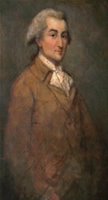
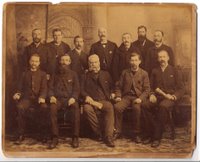
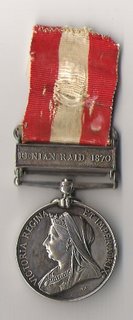





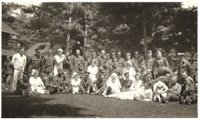







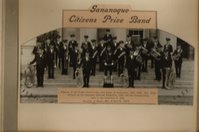
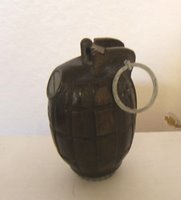






 These are two World War II gasmasks. The adult version is quite common, but the child’s mask is much rarer. Called a “Mickey Mouse” gas mask in the old catalogue, it was meant for children 5 and under. The accompanying box has a strap which would have been worn around the child’s neck, making the mask readily at hand in case of a Nazi gas attack.
These are two World War II gasmasks. The adult version is quite common, but the child’s mask is much rarer. Called a “Mickey Mouse” gas mask in the old catalogue, it was meant for children 5 and under. The accompanying box has a strap which would have been worn around the child’s neck, making the mask readily at hand in case of a Nazi gas attack.
